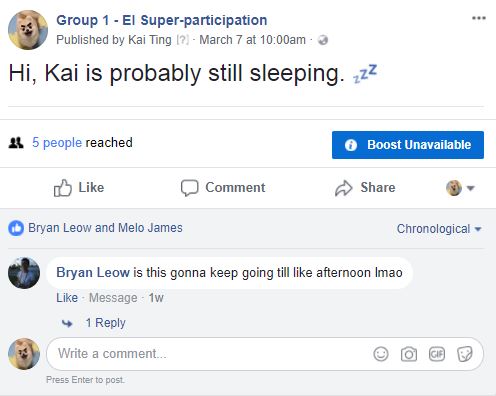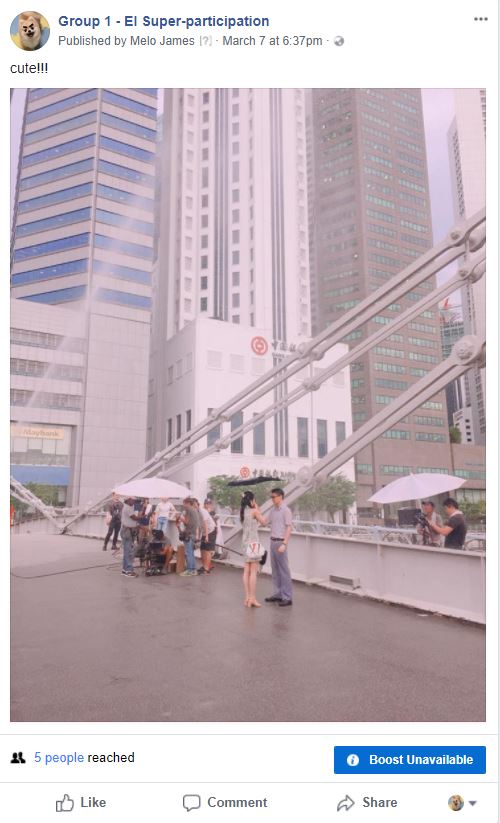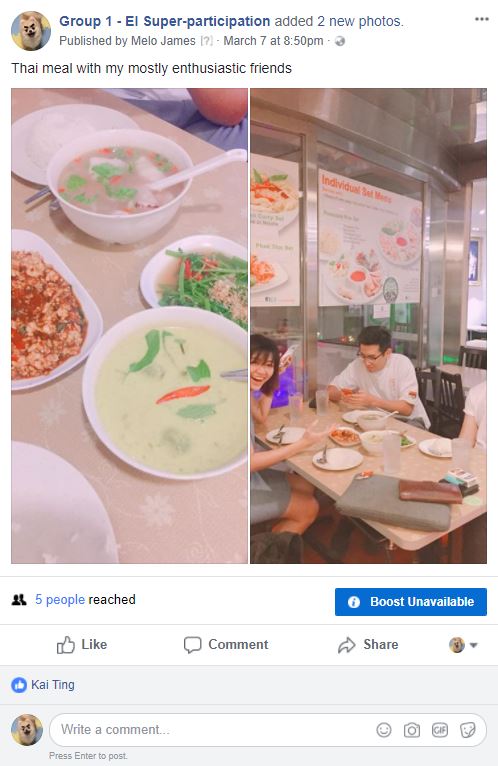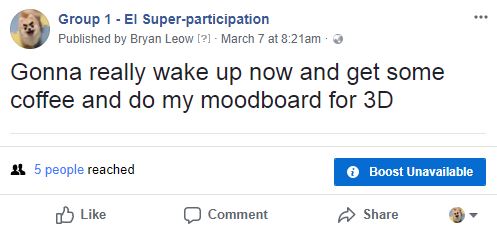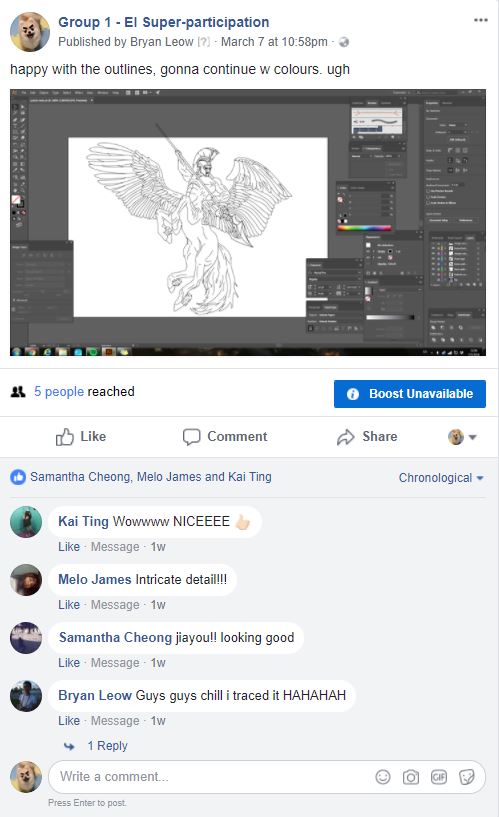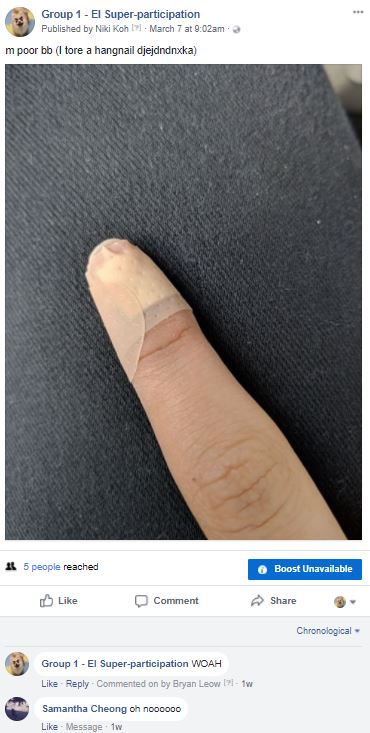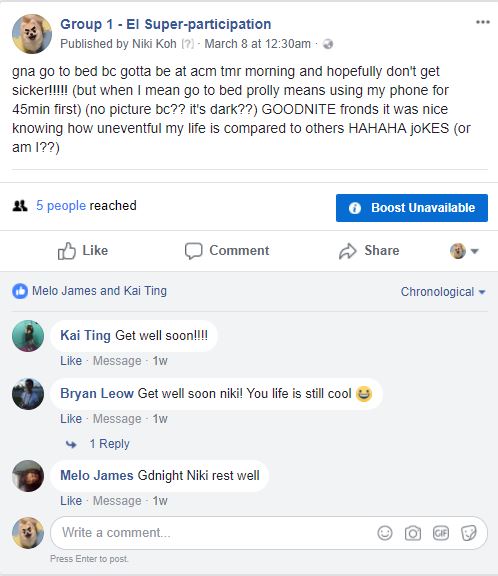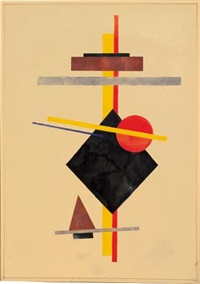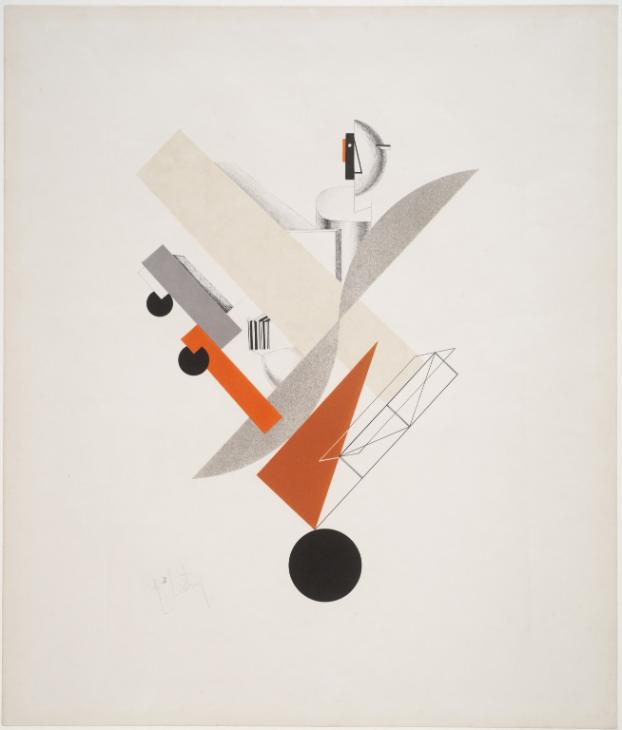In this project, my group (Myself, Melo, Bryan, Samantha and Nikki), were tasked to publish posts on Facebook during our recess week. Firstly, we did not set any rules but we agreed to start posting on Wednesday, 7 March, 8am for 24 hours.
To be honest, at the start, I did not know what to post. And knowing that I slept late the night before, I used the schedule option to schedule my posts at 8-10am. And yupp, when I woke up at 10am,everyone was already active on the Facebook page, posting about their daily activities, what they had for breakfast and there I was, still on my bed.
As the day went by, I got the hang of posting more things. However, I tend to not share too personal information online as I fear being judged. Afterall, the internet can be a scary place. So, I posted things which I only felt comfortable sharing, some trivial, but mostly about my daily activities and probably things that interest me, such as food. Also, I realised that throughout the day, I tend to forget to post certain things when I am busy with work or occupied at the moment. Because of this, some of my posts are not posted in real-time but are lagging behind an hour or so.
This micro-project motivated me to explore my digital identity in just 24 hours. I realised that as I was influenced and obliged to post, there are certain aspects about me that would not change, such as the type of posts or my attitude towards social media and perception of myself while using an online platform. Yes, I might have great control over what I can post and can entirely fake an identity if I wanted to. But because this was a closed group and that we knew everyone we were sharing our posts to, we naturally let our guards down and be comfortable with our posted content. From here, it is evident that the type of audience who have access to my information played a vital role in my content posted.
It was also an interesting journey as I get to understand each other’s persona through what we share.
Kai; The Chill One
I, myself, was identified as a person who is very chill, and sleepy (literally, as I woke up the latest and scheduled posts while I was asleep). My posts later on in the day learn towards more of a chill and relaxed vibe. All of these are in fact true to my real personality.
Melo; The Meticulous
As for my group member, Melo, we concluded that she is a meticulous person when it comes to aesthetics. Her posts have to be edited before she can post it online. Perhaps, as a person who enjoys looking at aesthetically pleasing photos, she would do the same when it comes to her as well. Nowadays, online content can be extremely influential to a person.
Bryan; The Workaholic
As for Bryan, we concluded that he was definitely the most hardworking group member out of all of us as he was already doing work early in the morning (while I was STILL asleep). Throughout the day, his photos about his work were posted consistently. To encourage one another, every one of us liked one another’s posts and gave nice comments – something which I felt, encompasses social media activities. “Likes”, “Favourites” and “Share”. All of these functions are extended ways we could express ourselves, rather than just words. This is also a unique aspect of online social media.
Niki; The “Trouble” Magnet
“Trouble” magnet not in terms of a bad way, by the way! Speaking of nice comments, what we remembered from Niki was that she was always in some sort of a “trouble” – whether if she was sick, or injured her finger. Mostly, we commented something encouraging, such as, “Get well soon!” etc.
Samantha; The Bubbly One
Lastly, as for Samantha, I felt that her posts were a mix of work and fun, like the video she posted of herself helping her friend to film. I also recalled that she posted a picture of food early in the morning and that definitely made me want to get breakfast too. The persona for her seemed to be a bubbly and active person.
Through super-participation in this micro-project, I have learnt that there are many intrinsic and extrinsic factors which influence the motivation of our actions on a social media platform. By analysing how we shape this online persona via our posts, we are able to uncover key behavioural insights from a person and indeed, we try to create a persona of how we want others to perceive us. However, in my opinion, there is a fine line between the degree of control we have; it all depends on the intent and aim. The example from Amalia Ulman proves us otherwise. Excellences & Perfections (2014), was an interesting example which displayed utmost control in creating a digital identity. It is a four month durational performance taking place directly on her personal Instagram. The artist fabricated a fictional character with the intention was to prove how easy an audience can be manipulated through the use of mainstream archetypes and characters they’ve seen before. Surely, no one went that far while creating a fake identity.
All in all, the exercise and the examples shown in class allowed me to see an array of personas and digital identify created (a range from actual self to perceived self).
